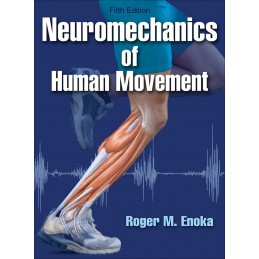- Obniżka


 Dostawa
Dostawa
Wybierz Paczkomat Inpost, Orlen Paczkę, DHL, DPD, Pocztę, email (dla ebooków). Kliknij po więcej
 Płatność
Płatność
Zapłać szybkim przelewem, kartą płatniczą lub za pobraniem. Kliknij po więcej szczegółów
 Zwroty
Zwroty
Jeżeli jesteś konsumentem możesz zwrócić towar w ciągu 14 dni*. Kliknij po więcej szczegółów
Neuromechanics of Human Movement, Fifth Edition, draws on the disciplines of neurophysiology and physics to explore how the nervous system controls the actions of muscles to produce human motion. This contemporary approach is much different from the traditional approach, which focuses solely on mechanics and does not consider the role of the sensorimotor system in the control of human movement. Authored by Roger Enoka, a widely recognized and esteemed scholar in neuromechanics, this influential text is an essential resource in biomechanics, motor learning, and applied physiology, making complex information accessible to students.
With material based on updated research in the field, this fifth edition provides a scientific foundation to the study of human movement, and as such it uses precise terms and definitions when discussing ideas. An appendix showcases both the base and derived units of the metric system as well as other learning tools, including a glossary of terms and a comprehensive list of the equations presented throughout the text. The text includes 70 practical learning examples, giving students the opportunity to work through a variety of problems and explore current research and applications. Content is visually reinforced with 341 figures, including specific illustrations of the neuromechanics involved in sport and rehabilitation movements. References have been streamlined and moved to the end of each chapter to improve readability. And instructors will benefit from an image bank that includes most of the figures and tables from the text to use in course materials.
Significant content updates in the fifth edition present information relevant for both research and clinical environments, including more contemporary examples throughout the text and a new chapter on movement analysis. The following are additional key changes::
• New figures that highlight and clarify key points
• New information on energy costs
• Debunking the concept of motor unit types
• Detailed information on the center of mass trajectory
• Explanation of neuromodulation
• Additional content on PET imaging to help examine activity intensity
To encourage a comprehensive learning experience, this updated edition follows a logical progression where each part builds on the material from the previous section. It begins with an introduction to the biomechanical terms and concepts commonly used to describe movement, focusing on the relation between force and motion. Part II deals with the motor system and introduces essential concepts from neurophysiology required for understanding how movement is produced by the nervous system. Part III focuses on adaptability of the motor system, including the acute and chronic changes that can occur in response to deviations in an individual’s level of physical activity.
The fifth edition of Neuromechanics of Human Movement provides a scientific basis for the study of human movement while continuing to expand current knowledge in the fields of biomechanics and neurophysiology. By integrating these fields in a unique framework, this text offers professionals and students both valuable clinical information and inspiration to deepen their study of human movement.
Opis
Part I. The Force–Motion Relationship
Chapter 1. Describing Motion
Measurement Rules
Motion Descriptors
Constant Acceleration
Up and Down
Scalars and Vectors
Linear and Angular Motion
Curve Fitting and Smoothing
Summary
References
Chapter 2. Movement Forces
Laws of Motion
Describing Forces in Human Movement
Forces Due to Body Mass
Forces Due to the Surroundings
Musculoskeletal Forces
Summary
References
Chapter 3. Movement Analysis
Static Analysis
Dynamic Analysis
Momentum
Work
Summary
References
Chapter 4. Running, Jumping, and Throwing
Walking and Running
Jumping
Throwing and Kicking
Summary
References
Part II. The Motor System
Chapter 5. Excitable Membranes
Essentials of Electricity
Resting Membrane Potential
Neurons
Synaptic Transmission
Electromyography
Summary
References
Chapter 6. Muscle and Motor Units
Muscle
Excitation–Contraction Coupling
Motor Unit
Muscle Mechanics
Summary
References
Chapter 7. Neural Control of Movement
Spinal Reflexes
Automatic Behaviors
Voluntary Actions
Summary
References
Part III. Adaptability of the Motor System
Chapter 8. Acute Adjustments
Warm-Up Effects
Flexibility
Muscle Soreness and Damage
Fatigue
Muscle Potentiation
Arousal
Summary
References
Chapter 9. Chronic Adaptations
Muscle Strength
Muscle Power
Adaptations to Reduced Use
Motor Recovery After Nervous System Injury
Adaptations With Age
Summary
References
